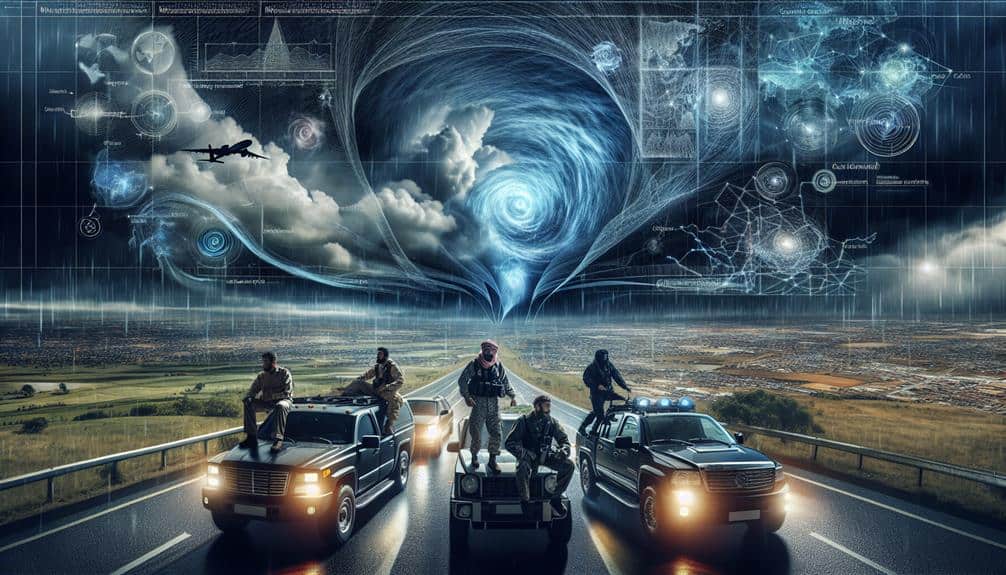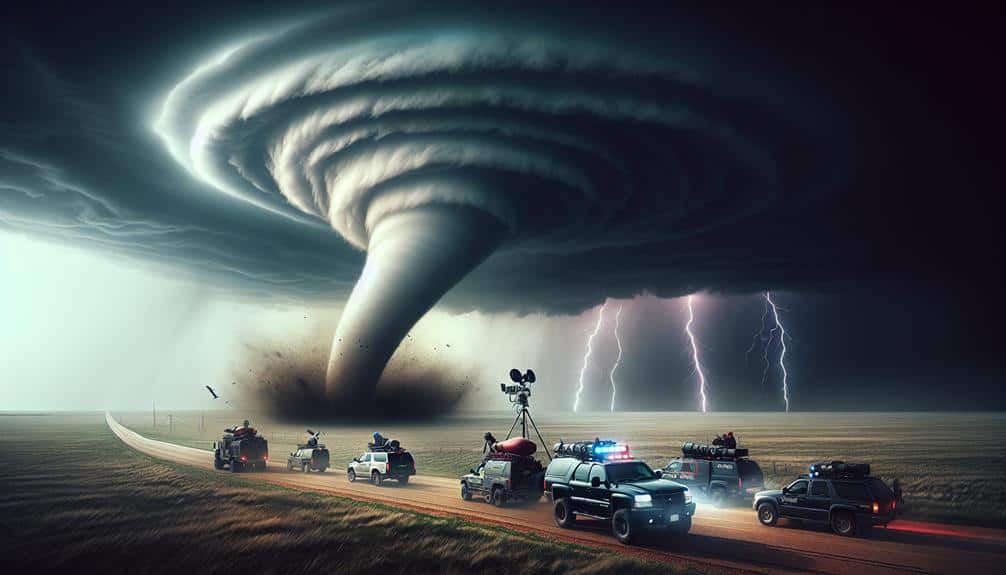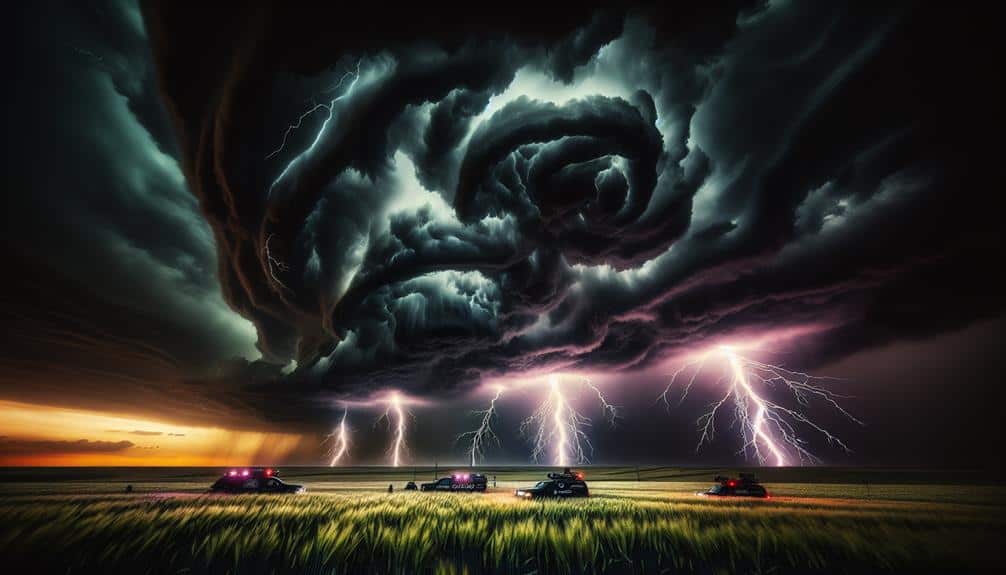We rely on innovative strategies in storm chasing competitions to transform chaos into scientific precision. Advanced technologies like state-of-the-art radar, AI prediction algorithms, and drones with sensors provide real-time meteorological data. This data aids in immediate analysis and dynamic decision-making, improving tracking accuracy. Seamless team communication, bolstered by pre-established protocols, guarantees swift, informed actions. We prioritize safety through rigorous training and cutting-edge equipment. Efficient route planning, supported by predictive modeling, helps us strategically navigate and allocate resources. Embracing these strategies not only keeps us safe but significantly enhances our competitive edge. Continue exploring to uncover the full depth of these innovations.
Key Points
- Innovative strategies enhance prediction accuracy and decision-making, ensuring storm chasers can intercept storms efficiently and safely.
- Real-time data analysis allows for adaptive strategies, optimizing route planning and resource allocation during rapidly changing storm conditions.
- Advanced technology integration, like drones and AI algorithms, provides precise measurements and forecasts, offering a competitive edge.
- Enhanced team coordination techniques ensure swift, informed decision-making, improving overall mission success and safety.
Advanced Technology Integration
We're leveraging state-of-the-art radar systems and high-definition satellite imagery to enhance our storm tracking accuracy. By integrating drone surveillance, we gain unparalleled insights into storm dynamics. These drones, equipped with advanced sensors, provide real-time data on wind speeds, temperature gradients, and atmospheric pressure. This data, when combined with AI prediction algorithms, allows us to model storm behavior with exceptional precision.
Our AI prediction algorithms analyze historical and real-time data to forecast storm paths and intensities. They consider variables such as humidity, temperature, and wind patterns, offering predictions that are both timely and dependable. This integration empowers us, giving us the freedom to make informed decisions quickly and efficiently.
Moreover, drones can safely venture into areas too hazardous for human storm chasers, capturing vital data without compromising safety. The synthesis of drone surveillance and AI prediction algorithms ensures that our storm chasing strategies aren't only innovative but also rooted in scientific rigor.
We're pushing the boundaries of what's possible, transforming storm chasing from a risky endeavor into a data-driven science. This technological edge is essential for staying ahead in storm chasing competitions, where accuracy and safety are of utmost importance.
Real-Time Data Analysis
Real-time data analysis allows us to interpret incoming data instantly, enabling swift and informed decision-making during storm chasing missions. By harnessing the power of predictive modeling and data visualization, we can anticipate storm movements and potential threats with remarkable accuracy. This not only enhances our tactical responses but also maximizes safety and efficiency in the field.
Incorporating real-time data analysis into our strategy offers several benefits:
- Immediate insights: Instantaneous interpretation of weather data lets us adjust our plans on the fly.
- Enhanced predictive modeling: By feeding live data into our models, we refine our predictions and improve storm tracking accuracy.
- Dynamic data visualization: Real-time maps and graphs make complex data comprehensible at a glance, aiding in quick decision-making.
To seize the freedom of the open road and the thrill of the chase, we rely on these sophisticated analytical tools. Real-time data analysis isn't just about reacting to the present; it's about anticipating the future. This foresight, driven by cutting-edge technology, keeps us ahead of the storm, turning raw data into actionable insights.
Team Coordination Techniques
Effective team coordination techniques are essential for synchronizing efforts and ensuring seamless communication during storm chasing missions. Our communication skills have to be impeccable to relay real-time data and adjust strategies instantly. This involves utilizing advanced communication tools, such as satellite radios and real-time messaging apps, to bridge any gaps in information flow.
Leadership dynamics also play an essential role. A designated leader must possess the ability to make quick, informed decisions while maintaining team morale and focus, ensuring that all members are on the same page.
When it comes to decision-making processes, we rely on a combination of pre-established protocols and situational awareness. Our team members are trained to assess meteorological data swiftly to make life-saving decisions. Teamwork cohesion is another vital element; every member must understand their role and trust each other's expertise. Regular drills and simulations help us refine our coordination and improve our response times.
Data-driven strategies are the backbone of our coordination techniques. By analyzing past missions, we can identify areas for improvement and adjust our approach accordingly. In storm chasing, the ability to adapt and coordinate efficiently can mean the difference between success and failure, freedom and constraint.
Safety Protocols Enhancement
Enhancing our safety protocols involves integrating cutting-edge technology and rigorous training to minimize risks during storm chasing missions. We must adopt advanced methodologies to guarantee both the thrill and safety of our ventures. Key elements in our approach include real-time data analysis and state-of-the-art equipment, which greatly improve our ability to anticipate and respond to volatile weather conditions.
Our training protocols are designed to instill a deep understanding of meteorological phenomena and emergency response strategies. By emphasizing risk mitigation, we can make informed decisions that prioritize our safety without compromising our pursuit of storm data.
- Advanced Radar Systems: Utilizing Doppler radar and mobile mesonets to provide real-time updates on storm development and movement.
- Emergency Response Drills: Regular, intensive training sessions simulate various emergency scenarios, ensuring team members are prepared for any situation.
- Personal Protective Equipment (PPE): Equipping teams with specialized gear, including reinforced vehicles and weather-resistant clothing, to safeguard against extreme conditions.
Efficient Route Planning

For efficient route planning, we must integrate real-time weather analysis with our logistical strategies to achieve best resource allocation.
By leveraging meteorological data and predictive modeling, we can dynamically adjust our paths to maximize observational opportunities while minimizing travel time and fuel consumption.
This approach not only enhances our competitive edge but also guarantees safety and efficiency in our storm chasing endeavors.
Real-time Weather Analysis
Real-time weather analysis leverages advanced meteorological data and predictive algorithms to optimize storm chasers' route planning, ensuring timely and accurate positioning. By utilizing predictive modeling, we can forecast the development and path of storms with high precision. This allows us to make informed decisions that not only enhance our chances of successfully intercepting storms but also minimize risk. Effective risk assessment is vital; it helps us prioritize safety without compromising our strategic objectives.
Predictive algorithms, combined with real-time data from radar, satellites, and on-ground sensors, provide us with a dynamic map of current and future weather conditions. This integration enables us to adapt our routes in real time, avoiding unnecessary detours and maximizing our time in the field.
Key aspects of real-time weather analysis include:
- Dynamic updates: Continuous feed of meteorological data for precise positioning.
- Predictive modeling: Advanced algorithms forecast storm paths and development.
- Risk assessment: Balances the thrill of the chase with safety considerations.
Optimal Resource Allocation
Building on our advanced real-time weather analysis, we must allocate resources efficiently to guarantee our route planning is both strategic and cost-effective. By leveraging high-resolution meteorological data, we can engage in resource optimization that maximizes our chances of intercepting storms while minimizing expenditure.
Efficient route planning isn't just about getting from point A to point B; it's about using predictive models to forecast storm paths and align our assets accordingly. Strategic decision making is essential. We need to prioritize fuel management, equipment readiness, and team deployment.
For instance, by analyzing atmospheric instability indices and convergence zones, we can determine ideal positioning. This reduces unnecessary travel and enhances our response time. Data from GPS tracking and mobile radar units further refine our logistical approach.
Moreover, historical storm data provides invaluable insights. By examining past patterns, we can anticipate potential developments and allocate our resources preemptively. This preemptive allocation avoids the pitfalls of reactive strategies, ensuring we're always a step ahead.
In essence, our ability to make informed, data-driven decisions on the fly allows us to navigate the complexities of storm chasing with a level of precision that guarantees both efficiency and freedom in our pursuit.
Competitive Edge Through Innovation
Harnessing cutting-edge technology and data analytics gives storm chasers a significant competitive edge in accurately predicting and tracking severe weather patterns. With advanced tools at our fingertips, we can make more informed decisions that enhance both our success rates and safety.
For instance, high-resolution radar systems and real-time satellite imagery allow us to conduct precise risk assessments, ensuring we're prepared for the unpredictable nature of storms.
Moreover, data-driven approaches enable us to execute strategic maneuvers that maximize our chances of intercepting the most dynamic weather events. By analyzing vast datasets on atmospheric conditions, we can predict storm paths more accurately and position ourselves advantageously.
To maintain this competitive edge, we utilize:
- Machine Learning Algorithms: These help in recognizing patterns in weather data that human analysis might miss.
- GPS Tracking Systems: Essential for real-time navigation and coordination among team members.
- Drones: Provide aerial views and measurements that ground-based instruments can't capture.
Frequently Asked Questions
How Do Storm Chasing Competitions Benefit Meteorological Research?
Storm chasing competitions drive research advancement by enhancing data collection and providing new meteorological insights. The competition dynamics foster innovation, leading to more precise forecasting models and a deeper understanding of severe weather phenomena.
What Personal Qualities Are Essential for a Successful Storm Chaser?
Did you know that 75% of storm chasers report facing extreme conditions? We need resilience and determination to navigate these challenges. Our ability to stay focused amidst chaos guarantees we collect accurate data, contributing to meteorological advancements.
How Do Participants Prepare Mentally for High-Stress Storm Chasing Scenarios?
We prioritize mental preparation and stress management through simulated scenarios and cognitive training. Consistent practice, mindfulness techniques, and data analysis help us stay focused and resilient, ensuring we can adapt swiftly in high-stress storm chasing situations.
What Role Does Public Education Play in Storm Chasing Competitions?
We prioritize public education in storm chasing competitions to enhance public safety and community engagement. By sharing data-driven insights, we empower communities to make informed decisions, reducing risk and fostering a culture of preparedness and resilience.
How Do Storm Chasing Competitions Impact Local Communities?
Storm chasing competitions impact local communities by boosting economic impact and fostering community engagement. However, they also heighten safety concerns and strain emergency response systems, necessitating careful planning and data-driven strategies to balance benefits and risks.


